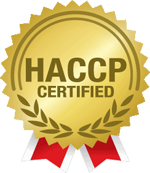HACCP Safety Training Courses: Seafood, Retail, State-of-the-Art Approach to Food Safety
Hazard Analysis & Critical Control Point (HACCP) - is a management system in which food safety is addressed through the analysis and control of biological, chemical, and physical hazards from raw material production, procurement and handling, to manufacturing, distribution and consumption of the finished product. Source: FDA - Hazard Analysis & Critical Control Point (HACCP)
Seafood Facts: October is National Seafood Month – a time to highlight smart seafood choices, sustainable fisheries, and the health benefits of eating a diet rich in seafood.
It's also an opportunity to illustrate U.S. fisheries successes and challenges as we turn the corner on ending overfishing and begin to rebuild fish stocks.
Seafood is sustainable when the fishery it was harvested from is managed in a way that sustains the use of the fishery and marine ecosystem for future generations.
HACCP involves seven principles:
- Analyze hazards. Potential hazards associated with a food and measures to control those hazards are identified. The hazard could be biological, such as a microbe; chemical, such as a toxin; or physical, such as ground glass or metal fragments.
- Identify critical control points. These are points in a food's production--from its raw state through processing and shipping to consumption by the consumer--at which the potential hazard can be controlled or eliminated. Examples are cooking, cooling, packaging, and metal detection.
- Establish preventive measures with critical limits for each control point. For a cooked food, for example, this might include setting the minimum cooking temperature and time required to ensure the elimination of any harmful microbes.
- Establish procedures to monitor the critical control points. Such procedures might include determining how and by whom cooking time and temperature should be monitored.
- Establish corrective actions to be taken when monitoring shows that a critical limit has not been met--for example, reprocessing or disposing of food if the minimum cooking temperature is not met.
- Establish procedures to verify that the system is working properly--for example, testing time-and-temperature recording devices to verify that a cooking unit is working properly.
- Establish effective recordkeeping to document the HACCP system. This would include records of hazards and their control methods, the monitoring of safety requirements and action taken to correct potential problems. Each of these principles must be backed by sound scientific knowledge: for example, published microbiological studies on time and temperature factors for controlling foodborne pathogens.
HACCP Food Safety Courses
- Seafood HACCP: 1hr
- HACCP: State-of-the-Art: 4hrs
- HACCP: Retail Food Establishments: 16hrs
Seafood HACCP Safety
Course Description
The Seafood HACCP online training course was developed to provide an easier method for individuals from the seafood industry and regulatory community to get training on the application of HACCP principles to seafood products.
The Seafood HACCP Course follows the Seafood HACCP Regulation that defines processing as handling, storing, preparing, heading, eviscerating, shucking, freezing, changing into different market forms, manufacturing, preserving, packing, labeling, dockside unloading, or holding fish or fishery products
Information in this course comes from the Hazardous Analysis and Critical Control Point Principles (HACCP) and Application Guidelines adopted by the USDA and FDA. Code of Federal Regulations 21 CFR Part 123 - Seafood HACCP Regulation - requires all seafood companies (domestic as well as international exporters to the United States marketplace) process products in accordance to HACCP principles as specified in the regulation.
Credit Hours: 1 hr
Cost: $75.00
Course Objectives
After completing this course, the student will be able to:
- Describe why a Hazard Analysis and Critical Control Point (HACCP) management system is an effective means for assuring food safety.
- Identify and distinguish between prerequisite programs for a HACCP management system.
- Discuss areas in which employees must receive education and training in order to understand their roles in producing safe foods.
- Identify the five preliminary tasks to be completed in the development of a HACCP plan before applying principles to a specific product or process.
- Discuss the seven principles of HACCP.
- Identify and describe the two stages involved in conducting a hazard analysis.
- Name and describe examples of possible CCPs.
- Identify and discuss the seven steps seafood companies must follow to help eliminate known hazards.
- Name five ways to test fish for freshness.
Course Outline
This course will discuss the following topics:
- Lesson 1: What is HACCP?
- Lesson 2: Implementation and Maintenance of the HACCP Plan
- Lesson 3: Seafood HACCP
- Lesson 4: Consumer Steps to Safer Seafood
Completion of Course
Each quiz must be passed with a miminum of 70% to proceed to the next lesson. Upon successful completion of the course, the certificate of completion will be available from the training page.
HACCP: The State-of-the-Art Approach to Food Safety
Course Description
Accredited by the International HACCP Alliance, this course aims to teach you the importance and use of all 7 principles in order to make you a safer, more effective food service employee.
Every operation serving or selling food needs to have a food safety system in place that is designed specifically to guarantee the food being served is safe to eat. This specific food safety system is called HACCP for Hazard Analysis and Critical Control Point. HACCP is a system comprised of 7 principles that are to be applied to a written food safety program focusing on the food in your operation.
This course meets the regulatory requirement of compliance with the 2013 FDA Food Code and the USDA Requirements for School District HACCP Plan Implementation.
Credit Hours: 4 hrs
Cost: $50.00
Course Objectives
After completing this course, the student will be able to:
- Identify the key points of HACCP
- Identify the causes of food borne illness
- Explain the 7 HACCP principles
- Apply standard operating procedures for food safety and food defense in your operation
- Follow prerequisite programs for food safety
- Identify the three classifications of recipes
- Apply critical control limits
- Determine critical control points
- Determine effective corrective actions
- Complete monitoring forms
Course Outline
The course consists of the following seven units:
- Unit 1: Introduction to HACCP
- Unit 2: Food Borne Illness
- Unit 3: The Seven HACCP Principles
- Unit 4: Identifying Hazards and Determining Critical Control Points
- Unit 5: Critical Limits, Monitoring and Corrective Actions
- Unit 6: Verification and Record Keeping
- Unit 7: Overcoming Barriers to HACCP Implementation
Completion of Course
Upon successful completion of the course, the certificate of completion will be available from the training page.
Food Safety HACCP for Retail Food Establishments
Course Description
Accredited by the International HACCP Alliance, this course presents the characteristics and application of Hazard Analysis and Critical Control Points (HACCP), a risk prevention management methodology that applies appropriate science and technology to plan, control, and document safe food processes in a food facility, consistent with the FDA’s desire to implement a voluntary HACCP program.
A Certified Food Safety HACCP Manager should be able to perform the following functions: Conducting preliminary activities, conducing hazard analyses, establishing detailed control measures, conducting verification activities, conducting operational implementation activities, and conducting continuous improvement activities.
The course first examines HACCP’s principles and concepts. The HACCP approach begins by identifying biological, chemical, and physical hazards (inputs to the system) associated with facility construction, equipment, employees, food and supplies.
The course also examines the prerequisite processes (e.g., personnel hygiene and training; equipment and facility cleaning, sanitizing, and maintenance; receiving and storage); and for food processes (e.g., cooking, hot and cold holding, and cooling), this course presents scientifically validated hazard control procedures that prevent, eliminate, or reduce hazards to levels that protect public health.
Finally, this course describes how HACCP is applied through Active Managerial Control (AMC) to establish a functional food safety management system.
Credit Hours: 16 hrs
Cost: $125.00
Course Objectives
After completing this course, the student will be able to:
- Identify the biological, chemical, and physical hazards in the food offered to consumers in a food system.
- Determine which hazards are significant risks.
- Determine, write, and validate adequate controls for those hazards.
- Write a Food Safety Management Plan that provides an appropriate level of protection for customers.
- Train and supervise employees to perform controls that strive for zero customer illness or injury during the life of the business.
Course Outline
This course will discuss the following topics:
- Lesson 1: The Food Safety Problem
- Lesson 2: The HACCP Approach to Food Safety
- Lesson 3: The Food Safety Management Plan
- Lesson 4: Physical Hazards in Food
- Lesson 5: Chemical Hazards in Food: Part 1
- Lesson 6: Chemical Hazards in Food: Part 2
- Lesson 7: Biological Hazards: Part 1
- Lesson 8: Biological Hazards: Part 2
- Lesson 9: Biological Hazards: Part 3
- Lesson 10: Biological Hazards: Part 4
- Lesson 11: Personal Hygiene and Control
- Lesson 12: Cleaning and Maintenance
- Lesson 13: Supplies
- Lesson 14: Menu HACCP
- Lesson 15: Recipe Engineering
Completion of Course
Upon successful completion of the course, the certificate of completion will be available from the training page.
NOAA Fisheries - Seafood Inspection Program
The National Oceanic and Atmospheric Administration (NOAA) oversees fisheries management in the United States. Under authority in the 1946 Agricultural Marketing Act, the NOAA Seafood Inspection Program provides inspection services for fish, shellfish, and fishery products to the industry.
The NOAA Seafood Inspection Program offers a variety of professional inspection services on a fee-for-service basis which assure compliance with all applicable food regulations. The Program offers sanitation inspection as well as system and process auditing in facilities, on vessels, or other processing establishments in order to be designated as participating establishments. Product quality evaluation, grading and certification services are available on a product lot basis. Certain products may be eligible for stamping with official marks, such as the U.S. Grade A, Processed Under Federal Inspection (PUFI) and Lot Inspection.
The services provided by NOAA include the following:
- Establishment Sanitation Inspection
- System and Process Audits
- Product Inspection and Grading
- Product Lot Inspection
- Laboratory Analyses
- Training
- Consultation
- Export Certification
These services can be provided nationwide, in U.S. territories, and in foreign countries. All types of establishments such as vessels, processing plants, and retail facilities may receive these services. All edible product forms ranging from whole fish to formulated products, as well as fish meal products used for animal foods, are eligible for inspection and certification.


